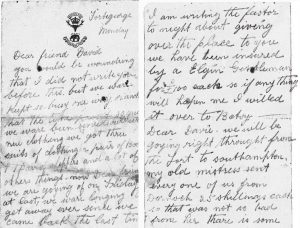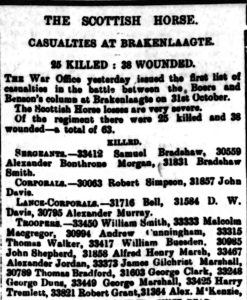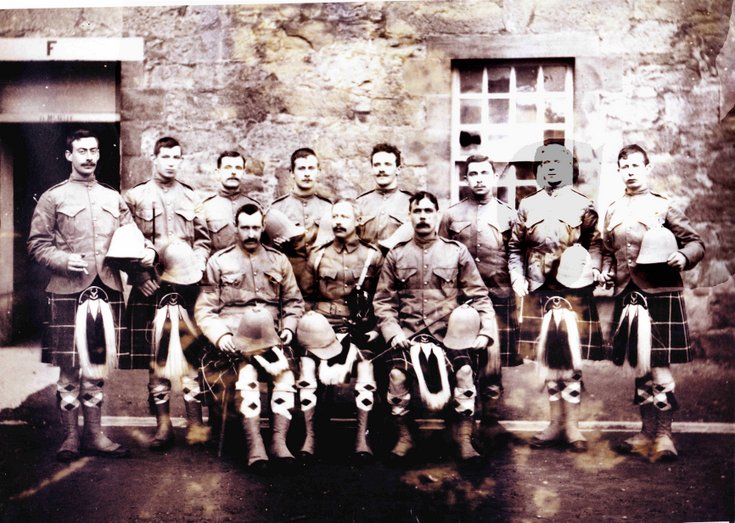Back in March, we posted a photo from the Second Boer War (1899-1902) on our Facebook page. At the time, we had no idea that it would lead to such a poignant journey of discovery, thanks to Forces War Records community member Rosie L. Rosie shared details of her great-great uncle Alexander Murrary who served during the conflict, and we couldn’t resist delving into the records to discover more about Alexander.
Early Life
Alexander was born in 1868 in the parish of Clyne, located in the North Highlands of Scotland in the county of Sutherland. His parents, John Murray and Helen Sutherland, married three years previously. John was a crofter (a tenant farmer), but Alexander sought employment as a gardener. Working his way up from a gardener’s apprentice, Alexander pursued this line of work until he joined the British Army.
Military Service
The Second Boer War commenced on 11 October 1899 and pitted Britain, and Commonwealth forces, against the Boer republics of the Orange Free State and the South African Republic. Bitter fighting and guerilla warfare dogged the conflict in South Africa, which lasted until 31 May 1902, when Boer forces accepted the terms of the Treaty of Vereeniging. Victory for the British came at a price: not only was it hugely expensive, but British and Commonwealth forces lost 22,000 personnel, over half to disease.
Early setbacks in the war, specifically the defeats endured during the ‘Black Week’ of 10-17 December 1899, convinced the British Government of the need for reinforcements. In a wave of patriotic fervour, volunteers came forward for service in South Africa; by the war’s end, over 100,000 British volunteers swelled the ranks, one of whom was Rosie’s ancestor, Alexander Murray.
Alexander enlisted on 16 January 1900 in Golspie, over ten miles north of Dornoch. His service record confirms that he was a gardener by trade, and family stories suggest that the mistress of the estate where Alexander was employed helped to raise men to fight in the conflict. In one of his letters, provided by Rosie, Alexander states: ‘my old mistress sent everyone [sic] of us from Dornoch 25 Shillings each so that was not so bad from her…’
Studying Alexander’s service record, we were offered a snapshot of his pre-war military experience, namely that he belonged to the 1st Sutherland Highland Rifle Volunteers. Volunteer rifle regiments saw a resurgence in 1859 in the wake of the French invasion scare. Members were part-time soldiers who agreed to a certain number of training days a year and an annual camp.
At the top of Alexander’s attestation page is the header ‘Short Service (One year with the Colours)’, indicating he joined up for one year of service, the stipulation placed on those who volunteered for service during Second Boer War. Alexander was 5 feet 8 1/2 inches tall and weighed 135 pounds, with a ‘fresh complexion’, grey eyes and dark brown hair. The physical description found in a service record provides a brief but valuable portrait of our military ancestors. This is especially valuable when researching ancestors before the advent of photography.
FWR Tip: If your ancestor was discharged from the British Army before WWI, try searching for their service record in our Royal Hospital Chelsea Pensioner Soldier Service Records.
Two days later, on 18 January, Alexander was passed fit for service with the Seaforth Highlanders at Fort George, Inverness. In a letter written from Fort George to his brother-in-law David, Alexander recounted:
‘You would be woundering [sic] that I did not write you before this but we were kept so busy one way or another that the time passed so quick, we have been served out with new clothing we got three suits of clothing two pair of boots and one pair of slippers and a lot of other things…’
Alexander and his fellow recruits left Fort George for Southampton the following month, ready to depart for South Africa and overseas service:
‘…we are all in the best of spirits and longing to get to the front, you would wonder the difference that is on us since we came up here you should see us in the Khaki uniform it makes us quite soldier like…’
The khaki drill uniforms Alexander and his comrades were kitted out in were far more practical than the red woollen tunics previously worn by the British Army in battle. The army gradually adopted khaki drill uniforms in the nineteenth century.

Overseas Service
On 24 February, a contingent of nine officers and 339 men of different units left Southampton for Cape Town on board the SS Mexican. Alexander, now part of the 2nd Battalion Seaforth Highlanders, was one of the men on board. Incidentally, the Mexican sank, returning to Southampton in April following a collision.
Alexander served in South Africa with the Seaforth Highlanders until 12 April 1901. According to his service record, he was entitled to the Queen’s South Africa Medal with the Wittebergen and Cape Colony claps. Clasps were worn on the medal ribbon and indicated the specific battles and campaigns the recipient participated in during the war.
FWR Tip: The ‘Military History Sheet’ of your ancestor’s service record indicates the medals they were entitled to.
On 12 April 1901, Alexander was discharged following his year of service. However, that did not spell the end of Alexander’s participation in the Second Boer War. On 24 April, evidently keen to carry on serving, he joined the Second Regiment of the Scottish Horse, a yeomanry regiment. The regiment was formed in late 1900 for service in the Boer War; it took in Scottish recruits from South Africa, as well as other locations. Enrollment forms for this unit are held at The National Archives in Kew: Local Armed Forces, Enrolment Forms, South African War.

In a letter to his brother-in-law, penned while stationed at Fort George in 1900, Alexander poignantly wrote: ‘hoping to see you all some day’. Sadly, this day would not arrive. Lance Corporal Alexander Murray, according to our Boer War casualty roll, was killed in action on 30 October 1901 at the Battle of Bakenlaagte. The battle saw Alexander’s column, heading to its camp, come under attack from Boer commandos, resulting in 88 British fatalities, 33 from the Scottish Horse. Alexander’s name appears in a casualty list from the battle, published in the Perthshire Advertiser in November 1901.
FWR Tip: It is always worth searching for military ancestors in newspapers. You may find references to your ancestor in their local paper, which often published casualty lists, details of brave actions and medal awards, letters and sometimes photos of the service person.
One record that proved crucial in our search for Alexander was his entry in the Soldiers’ Effects Records. The collection details payments to the next of kin of soldiers who died serving with the British Army. Entries for Boer War casualties often provide the person’s occupation, where they were born, and when they enlisted. The collection helped us identify Alexander with his second unit and work backwards in our research. We knew, from Rosie, that Alexander was a gardener and that he died in October 1901. These details helped us identify him in the collection and confirmed that he was serving with the Scottish Horse when he died. Alexander’s entry also references his previous service with the Seaforth Highlanders, for which he received a volunteer gratuity and a war gratuity.

Alexander’s sister Elizabeth (referred to as Betsy in his letters) was the recipient of her brother’s financial compensation, which amounted to 41 pounds, 19 shillings and ten pence. The addition of Alexander’s next of kin, whose name tied in with the letters Rosie provided us, helped to confirm we had the right man in the records.
Alexander’s story emphasises how our personal family history collections, like photographs, letters, newspaper articles, and family stories, go hand-in-hand with military records. The clues held in your personal collections, such as a photo of an ancestor in uniform, or a letter from the frontlines, could help you to start your research journey. They can also be decisive in narrowing your results and identifying your ancestors in records. A cap badge in a photograph, a regimental number recorded in a letter, or a location referenced in a family story could prove to be the difference when searching for your military ancestors.
Do you have a story of a military ancestor you’d like to share with us? Feel free to tell us about them in the comments below or on our social media pages, and perhaps we’ll feature them in one of our future blog posts.
Sources
AngloBoerWar.com, accessed June 2023.
AngloBoerWar.com, accessed June 2023.
The South African Military History Society: Bakenlaagte, Military History Journal, Vol 18 No 4, June 2019, 30 October 1901, Robin Smith, accessed June 2023.
National Army Museum, accessed June 2023.
The London Gazette, accessed June 2023.
Project Muse: Volunteers on the Veld: British Citizen-Soldiers and the South African War, 1899-1902 (review), Victorian Studies, Indiana University Press, Volume 51, Number 3, Spring 2009, pp. 543-544, accessed June 2023.
Ancestry: 1881 Scotland Census
Ancestry: Scotland, Select Marriages, 1561-1910
Transcript of Alexander’s full letter provided by Rosie L.

